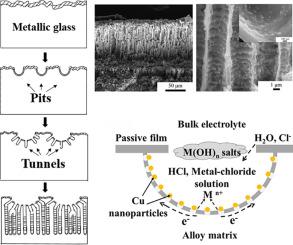当前位置:
X-MOL 学术
›
Mater. Des.
›
论文详情
Our official English website, www.x-mol.net, welcomes your
feedback! (Note: you will need to create a separate account there.)
Honeycomb-like porous metallic glasses decorated by cu nanoparticles formed by one-pot electrochemically galvanostatic etching
Materials & Design ( IF 7.6 ) Pub Date : 2020-11-01 , DOI: 10.1016/j.matdes.2020.109109 Xuekun Luo , Mengmeng Meng , Ran Li , Zian Li , Ivan S. Cole , Xiao-Bo Chen , Tao Zhang
Materials & Design ( IF 7.6 ) Pub Date : 2020-11-01 , DOI: 10.1016/j.matdes.2020.109109 Xuekun Luo , Mengmeng Meng , Ran Li , Zian Li , Ivan S. Cole , Xiao-Bo Chen , Tao Zhang

|
Abstract Pitting corrosion is a common localized corrosion phenomenon, which can lead to cracks and mechanical failure in structural metal materials. On the contrary, pitting corrosion could be a beneficial tool for generating large-area porous structures, which holds a great premise in a number of functional services, such as catalysis, sensing, storage, imprint lithography, and membranes. Herein we presents an electrochemical approach for creating a large-area honeycomb-like porous structure in Zr-based metallic glasses. A pitting process followed by subsurface tunnel etching in NaCl solution elicits to characteristic micrometer scale channels and nanometer size amorphous sidewalls decorated by Cu nanoparticles on the metallic glass substrate. A root-shape growing mechanism of tunnels initiated from pits and penetrating into alloy matrix is postulated. In addition, the effect of alloy composition on the microstructure of honeycomb-like porous metallic glasses is also investigated in detail.
中文翻译:

一锅电化学恒电流蚀刻形成的铜纳米颗粒装饰的蜂窝状多孔金属玻璃
摘要 点蚀是一种常见的局部腐蚀现象,会导致金属结构材料产生裂纹和机械失效。相反,点蚀可能是生成大面积多孔结构的有利工具,这在催化、传感、存储、压印光刻和膜等许多功能服务中占有重要地位。在此,我们提出了一种在 Zr 基金属玻璃中创建大面积蜂窝状多孔结构的电化学方法。点蚀过程随后在 NaCl 溶液中进行地下隧道蚀刻,在金属玻璃基板上产生由 Cu 纳米颗粒装饰的特征微米级通道和纳米级无定形侧壁。假设了一种从凹坑开始并渗透到合金基体中的隧道根状生长机制。此外,还详细研究了合金成分对蜂窝状多孔金属玻璃微观结构的影响。
更新日期:2020-11-01
中文翻译:

一锅电化学恒电流蚀刻形成的铜纳米颗粒装饰的蜂窝状多孔金属玻璃
摘要 点蚀是一种常见的局部腐蚀现象,会导致金属结构材料产生裂纹和机械失效。相反,点蚀可能是生成大面积多孔结构的有利工具,这在催化、传感、存储、压印光刻和膜等许多功能服务中占有重要地位。在此,我们提出了一种在 Zr 基金属玻璃中创建大面积蜂窝状多孔结构的电化学方法。点蚀过程随后在 NaCl 溶液中进行地下隧道蚀刻,在金属玻璃基板上产生由 Cu 纳米颗粒装饰的特征微米级通道和纳米级无定形侧壁。假设了一种从凹坑开始并渗透到合金基体中的隧道根状生长机制。此外,还详细研究了合金成分对蜂窝状多孔金属玻璃微观结构的影响。











































 京公网安备 11010802027423号
京公网安备 11010802027423号